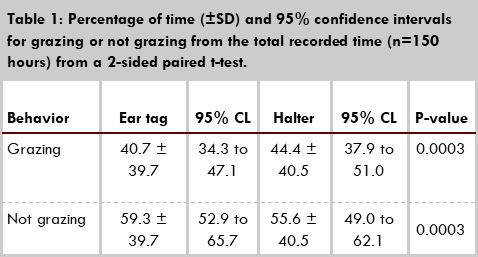By Glenda Pereira1, Brad Heins1, Bernadette O’Brien2, Arleen McDonagh2, and Laura Lidauer3
1U of MN, WCROC, Morris, MN, 2Teagasc, Animal & Grassland Research and Innovation Centre, Moorepark, Fermoy, Co. Cork, Ireland, and 3Smartbow GmbH, Weibern, Austria
May 2019
Introduction
Pasture-based dairy production systems are becoming more common in the global dairy industry (USDA, 2016), and grazing dairy producers may benefit from utilizing precision dairy technologies. However, the majority of work conducted with precision technologies has been in confinement systems. In a grazing herd, a halter with a noseband pressure sensor accurately recorded grazing behavior of cows (Werner et al., 2018). Grazing behavior may be difficult to define because grazing may be considered as both active and eating behaviors because cows may graze while standing or while walking. The objectives of this study were to develop a grazing algorithm for an ear attached accelerometer (Smartbow GmbH, Weibern, Austria) and to validate the ear attached accelerometer for grazing behavior.
Validation of Grazing Behavior
The study was conducted at the University of Minnesota grazing dairy in Morris, Minnesota, USA and at the Teagasc, Animal & Grassland Research and Innovation Centre in Moorepark, Fermoy, Co. Cork, Ireland. During May and June of 2017, ear attached accelerometers were attached to cows and three observers visually recorded behaviors of grazing cows for a total of 90 hours. The observational data from Minnesota and some additional data from Ireland was used to create a master dataset. From the dataset, 2/3 of the data was used for training the data and developing a grazing algorithm and 1/3 of the data was used for testing the ear attached accelerometers grazing algorithm. In addition to an acceleration sensor, the Smartbow ear attached accelerometer includes a radio chip, and temperature sensor. The ear attached accelerometer can monitor estrus detection and rumination by acceleration data from ear and head movements.
To validate the ear attached accelerometers grazing algorithm, a halter and noseband pressure sensor system (Rumiwatch, Itin and Hoch GmbH, Liestal, Switzerland) was utilized. The halter was comprised of a 3 axis accelerometer which recorded acceleration patterns and a noseband pressure sensor which detected jaw movements according to chewing activities (Werner et al., 2018). During September of 2018, data were collected from the ear-tag and halter system in Minnesota and Ireland.
In Minnesota, the ear attached accelerometers and the halter systems were attached to 12 crossbred cows for 4 days for each cow. Cows were offered pasture for 22 hours per day. Cows were milked twice per day in a swing-9 parabone milking parlor. The pastures were comprised of grasses and legumes that included smooth bromegrass, orchardgrass, meadow fescue, alfalfa, red clover, and kura clover. Cows were stocked at a rate of 3 cows per hectare and were rotated to new paddocks every 2 days, with 3,796 kg of DM/ha available at the start of grazing.
The ear attached accelerometer and halter system were compared for number of grazing minutes per hour, during 150 hours under the Minnesota grazing conditions. A 2-sided paired t-test compared the percentage of time recorded for grazing behaviors by the halter and ear attached accelerometer. Pearson correlations evaluated associations between the halter and ear attached accelerometer for grazing behavior. For total recorded time, the percentage of time recorded for the ear attached accelerometer for grazing and non-grazing were 40.7 % and 59.3%, respectively (Table 1). Similarly, the percentage of time recorded by the halter system for grazing and non-grazing were 44.4 and 55.6%, respectively (Table 1). Correlation of grazing behavior was 0.95 (P < 0.01) for the ear attached accelerometer and halter system.

Conclusion
The results suggest that the ear attached accelerometer accurately monitored grazing behavior in a pasture-based system. Although this algorithm is not commercially available yet, there is great potential for the ear attached accelerometer to be utilized in pasture based dairy production systems to support farm management decision making.
